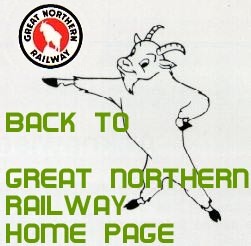|


| |
GN Electric Operations continued
anyone, as the main generators can be 'burned out' by
repeated overloading of just a little above: continuous
rating.
Continuous D. C. armature amperes — General Electric
550 and Westinghouse 2500.
If a train does not roll free on continuous D. C. amperes,
then it is either (1) brakes sticking, (2) helper or head
end not doing their share. Watch this, as the power chart
shows who does their stuff. (3) Over tonnage.
Just a point of information, which you can verify by a
visit to substations: the chart shows every move
everyone in train engines makes, including conductors who pull
air from caboose unnecessarily.
Helper Service Tonnage Freight Trains, Motoring
The helper engine must be worked as follows for
satisfactory operation. Starting: notch out gradually on
receiving starting signal, and build up D. C. amperes to
necessary values. General Electric engines use about 550 to 700
amperes D. C. Westinghouse engines work D. C. amperes
up to 2000—2500. Gradually, and if train does not move,
then increase gradually to about 4000 D. C. Wheel
slipping usually begins on sand at and above 4000 D. C. The
amperages indicated may be applied and held for twenty
to thirty seconds steadily to crack a train loose, and then
after train begins moving, these maximum ampere values
may be held steady for five minutes to help accelerate train.
When running speed is reached, all meters normally should
be out of RED and not exceeding continuous amperes for
steady running.
DANGER: WHILE ACCELERATING BE CAREFUL
NOT TO EXCEED PEAK LOAD OR DISPATCHED
SYNCHRONOUS AMPERES ON ANY CAB.
There is no margin for you there. Use given amperes, or a little
less, but never exceed them. That means trouble.
Helper Service Regeneration
The swing helper system used on Great Northern Railway
electrification consists in cutting all locomotives into
train, so that all units are pulling their tonnage up grade,
as: tonnage 5,250; 105 cars; on 2.2% grade, three
General Electrics on head end pull 3000 tons, while back about
sixty cars in train, the swing helper is cut in, three
Westinghouse, trailing about 45 cars, or 2250 tons. This
system was found by test to be most satisfactory for pulling
trains up grade.
Page 41
However, due to the electric locomotive maximum
regenerating tonnage capacity being much greater than their
pulling capacity, note carefully the following:
In regeneration on 2.2% grade the same three General
Electric and three Westinghouse units could hold back,
or regenerate, 7500 to 7900 tons at fifteen to eighteen miles
per hour, depending on adhesion and rail conditions, so
that the full tonnage capacity of electrics pulling a train
up 2.2% grade is only about an average of 65 to 70% of
what they could hold back in regeneration down the same
grade and at their continuous running speed of fifteen to
eighteen miles per hour. From the increased capacity that
all of the electrics have in regeneration, it naturally
follows that if helpers in swing position are operated at their
full regeneration capacity, they will hold back not only the
tonnage coupled behind them, but some of the tonnage
ahead of swing helpers, which means some of the slack
between road engine and swing helper will be stretched.
This stretching of slack in regeneration must be avoided at
all times. Regeneration is basically a bunched slack
operation, and any other condition is dangerous. This has been
proven by serious derailments where the helper was
holding too much in regeneration, so that some of slack was
stretched between head end and helper. Then a sudden air
stop had to be made. The brakes' action from head end
toward rear of train was met by the action of the stretched
slack piling up from between swing helper and head end.
Result — where the slack action and brake action met, cars
were kicked clean out of these trains.
Swing helpers are used on all tonnage freight trains,
as originally tests were made on electrified grade that
indicated with regular A. A. R. knuckles, etc., starting a
trailing tonnage on 2.2% grade in excess of 2500 tons
usually resulted in broken knuckles and drawbars. This was
on a dead lift and no jerking or taking slack entered in.
If all helpers and road engines were on head end in
regeneration, the only limit then to be considered would be
the crushing strength of cars. However, swing helpers will
so handle their electric engines that they hold the tonnage
behind them, and never let their engines stretch any slack
ahead of them. This is the only safe way to operate, and
since no two trains are alike, the example will merely
indicate how most tonnage trains are handled.
Typical: Down 2.2% grade. 5250 tons. Three General
Electrics on head end and three Westinghouses in swing.
Speed twenty miles per hour.
Page 42
Three General Electrics —
D. C. field 400 amp.
D. C. Arm. 400 to 500 amp.
Three Westinghouse —
D. C. field 2000 to 2200 amp.
D. C. Arm. 2200 to 2600 amp.
Three General Electric and three Westinghouse units, 5250
tons, down Chumstick 1.6% grade, speed thirty to thirty-
five miles per hour, all cabs regenerating:
Three General Electrics —
D. C. field 300 to 400 amp.
D. C. Arm. 400 to 500 amp.
Three Westinghouse —
D. C. field 1500 to 2000 amp.
D. C. Arm. 2000 to 2500 amp.
The train slack is always kept bunched. When engineers
on head end and swing work together closely, they
have full and instant knowledge of conditions from their
meters and complete control of conditions by means of
their speed and field controllers.
When troubles occur in regeneration and trains are
damaged, or air has to be used to supplement regeneration and
no line or motor troubles are evident, it is strictly a case
of "man trouble" and easily noticeable on substation charts,
so engineers will be doubly alert and on job in regeneration
as there is little excuse for trouble here. Trains have been
handled successfully for over ten years without incident in
regeneration, so long as engineers observed the rules and
instructions. The few troubles experienced were distinctly
a case of non-observance of instructions, which is dangerous
practice and will not work here.
Remembering that the electric locomotive K. W. H.
recording meters, the engine speed tape and the substation
power charts all combine to keep a 100% check on the
movements through electric zone of every individual unit
and man running it, there is no use in anyone trying to pull
any stunts. This merely for your information on the job.
Follow instructions to the letter.
Trains Starting From Standstill Down Grade
Helper may put his engine in regeneration from standstill,
but do not pick up load until train is all bunched,
and speed about five miles per hour. Then hold what's
behind you.
Page 43
Trains Starting Down Grade Without Stopping
Helper will make his proper setup for regeneration, then
gradually pick up proper load for the tonnage and grade
condition, remembering that train speed must not exceed
the running speed, or regeneration kickouts are liable.
Example: if train speed will be eighteen to twenty miles per
hour, be in regeneration and holding your load at around
fifteen miles per hour. You can always increase speed
easily, but not always check it once a train gets rolling too
fast for regeneration.
Other Methods Tried For Controlling Regeneration
The basic principle of regeneration is: bunched slack, and
it must be kept bunched at all times, regardless of how
many cabs are in swing helper position and regardless of
tonnages ahead of, or behind swing helper. The engineer
has his meters and master controllers to properly control
load at all times, and under all conditions. Because some
individuals failed to follow instructions, we were forced
to try and make a setup that was near fool proof. This
consisted in shutting down enough helper cabs or units on
the grade where the full capacity being used would not
stretch slack between helper and head end. This worked
okay so long as all men worked together and took their
full share of load. The trouble was that the motors which
were in service were crowded to limits and damaged from
flashovers, skidded wheels, etc. Hence, men must run these
engines according: to instructions or keep away from the
electric zone.
Stalling or Stopping a Train Ascending Grade
Passenger trains ascending grade and making a signal
stop for a red block, should ease off controller and reduce
speed at sufficient distance away, so that train stop is made
from a smooth drift to stall with slack stretched, and
controller notched just far enough to keep train from rolling
back, then whistle off and notch out to speed up.
Freight Trains Stopping on Ascending Grade
Due to the slack, train momentum and two engine crews
separated by numerous cars, freight stops must be
carefully made as follows:
(1) Head end wishes to stop for any reason. Ease off
controller one or two notches at a time, then wait so that
helper engineer can follow you, as the load dropped by
head end piles up on helper engine causing D. C. amperes
Page 44
 
 
|